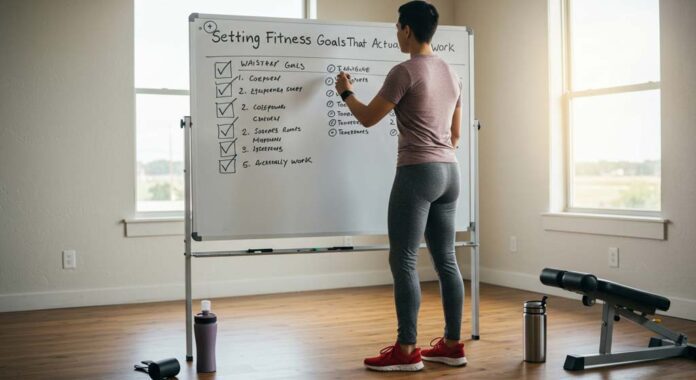Setting fitness goals often feels like building a house without a blueprint. We know we want to get fitter and healthier, but many struggle to create a stick plan. Just like a builder needs the right tools and plans, we need proper guidance to achieve our fitness aims.
The good news? Setting fitness goals isn’t about following complicated rules or strict programs. Research shows that people who create clear, achievable targets progress significantly in their fitness journey. Whether starting from scratch or picking up where you left off, the foundations of good health begin with understanding what works for you.
Think of your fitness journey like growing a garden. You wouldn’t expect seeds to bloom overnight. Similarly, lasting changes happen when we take small, consistent steps forward. Research reveals that regular goal-setting leads to better results than random attempts at getting fit.
The right approach makes all the difference. When people follow proven strategies, they experience notable improvements in their well-being. Regular movement enriches every aspect of life, from having more energy to feeling more vigorous.
Ready to create fitness goals that actually work? Let’s explore practical strategies that fit your life, backed by solid research but designed for real people like you and me.
Why Most Goals Fail (And How to Fix That)
The path to setting fitness goals for success often starts with good intentions but stumbles along the way. Research reveals that without proper planning, even the most potent motivation fades. Most people aim too high too quickly, leading to frustration and giving up.
Understanding why goals fail helps prevent these common pitfalls. Health experts note that unrealistic expectations create unnecessary pressure. Focusing solely on outcomes like “lose 20 pounds” rather than actionable behaviours also sets us up for disappointment.
Time after time, research shows successful people break their targets into manageable chunks. For instance, rather than declaring, “I’ll exercise every day”, start with three days weekly. Furthermore, celebrating small wins builds confidence and maintains motivation.
Common Goal-Setting Mistakes to Avoid:
- Setting targets without considering current fitness level
- Choosing goals based on others’ achievements
- Lacking straightforward ways to measure progress
- Missing specific actions to achieve results
Achieve success in setting fitness goals requires honest self-assessment. Research indicates that personalised objectives based on individual capabilities lead to better outcomes. Consequently, evaluating your starting point creates a solid foundation for progress.
Identifying personal barriers plays a vital role in goal achievement. Studies highlight that people who plan for obstacles succeed more often. Moreover, having strategies ready when motivation dips keeps you moving forward.
Specific
Clear and precise targets
Example: “Walk 30 minutes daily”
Measurable
Trackable progress
Example: “8,000 steps per day”
Action-oriented
Based on behaviors
Example: “Exercise 3 times weekly”
Realistic
Achievable targets
Example: “Start with 10 minutes”
Timed
Clear deadlines
Example: “Within 4 weeks”
Making Your Goals Measurable and Achievable
Creating meaningful fitness targets requires more than wishful thinking. Research demonstrates that highly specified goals increase behaviour change significantly. Therefore, each goal needs clear markers for success.
The SMART framework (Specific, Measurable, Action-oriented, Realistic, and Timed) is a proven guide for setting fitness goals. Let’s examine how this works in practice:
- Specific: Instead of “get fit”, choose “walk briskly for 30 minutes.”
- Measurable: Track your progress using time, distance, or repetitions
- Action-oriented: Focus on behaviours you can control
- Realistic: Match goals to your current abilities
- Timed: Set clear deadlines for achievement
Evidence shows that setting fitness goals with measurable outcomes improves success rates]. For example, rather than “be more active”, aim to “complete 8,000 steps daily by month’s end”.
Physical activity guidelines provide helpful benchmarks. Studies recommend building up to 150-300 minutes of moderate activity weekly. However, remember to adjust these targets based on your starting point.
Technology offers valuable tools for tracking progress. Research reveals that monitoring achievements helps maintain momentum. Regular check-ins allow you to adjust goals, ensuring they remain challenging yet achievable.
Smart Strategies for Setting Fitness Goals
Research reveals that personalised goal-setting approaches produce better results than generic plans. Understanding your starting point helps create a solid foundation for setting fitness goals.
Successful strategies often include tracking different aspects:
- Exercise vital signs (intensity, duration, type)
- Weekly activity levels
- Progress markers
- Recovery patterns
Health data shows starting slowly builds lasting habits. The recommended baseline includes 150 to 300 minutes of moderate activity weekly. However, each person’s path differs based on current abilities and lifestyle.
Setting fitness goals becomes more effective with proper guidance. Studies indicate that support systems significantly improve success rates. Regular check-ins help identify what works and what needs adjustment.
Creating clear action steps makes goals achievable. Research highlights that people often succeed when breaking larger targets into smaller tasks. For example, establish weekly milestones rather than focusing solely on an end target.
Progress monitoring plays a vital role in maintaining momentum. Studies show that tracking improvements, even small ones, helps sustain motivation. Recording achievements provides concrete evidence of growth.
Goal Setting Action Plan
1. Assess Current Level
- Fitness baseline
- Available time
- Resources
2. Set Primary Goal
- Use SMART criteria
- Be specific
- Set timeframe
3. Create Action Steps
- Weekly targets
- Daily actions
- Progress measures
4. Track Progress
- Use technology
- Monitor regularly
- Record achievements
5. Review and Adjust
- Evaluate progress
- Modify as needed
- Set new challenges
Using Technology for Setting Fitness Goals
Modern tools offer great ways to enhance goal achievement. Research demonstrates that technology helps bridge the gap between intention and action. Apps and devices provide immediate feedback on progress.
Wearable technology transforms how we track fitness activities. Studies reveal that monitoring devices help maintain consistent exercise habits. These tools offer:
- Heart rate tracking
- Movement monitoring
- Exercise logging
- Activity reminders
Evidence shows that technology-based tracking improves adherence to exercise programmes. Real-time data helps people understand their patterns and adjust accordingly. Furthermore, digital tools make it easier to spot trends over time.
Regular monitoring through technology strengthens the relationship between goals and actions. Research indicates that data feedback helps people stay connected to their objectives. Additionally, seeing progress in numbers or graphs provides concrete motivation.
Smart devices enable personalised goal adjustments. Studies confirm that adaptive approaches based on individual responses yield better results. Moreover, technology helps identify when goals need updating to maintain challenge and interest.
Fitness success stems from understanding proven principles and applying them consistently. Research demonstrates that combining clear targets with proper tracking creates sustainable progress. The tools and strategies discussed and shown in the above chart provide a robust framework for achieving meaningful improvements in health and fitness.
Sources
- Almirall D, Nahum-Shani I, Sherwood NE, Murphy SA. Introduction to SMART designs for the development of adaptive interventions: with application to weight loss research. Translational Behav Med. 2014;4(3):260–74.
- Artinian NT, Fletcher GF, Mozaffarian D, et al. Interventions to promote physical activity and dietary lifestyle changes for cardiovascular risk factor reduction in adults: a scientific statement from the American Heart Association Jul 27. Circulation. 2010;122(4):406-41.
- Bailey RR. Goal setting and action planning for health behavior change. Am J Lifestyle Med. 2019;13:615–618.
- Batrakoulis A, Jamurtas AZ, Georgakouli K, Draganidis D, Deli CK, Papanikolaou K, et al. High intensity, circuit-type integrated neuromuscular training alters energy balance and reduces body mass and fat in obese women: a 10-month training-detraining randomised controlled trial. PLoS One. 2018;13:e0202390.
- Bovend’Eerdt TJ, Botell RE, Wade DT. Writing SMART rehabilitation goals and achieving goal attainment scaling: a practical guide. Clin Rehabil. 2009;23:352–361.
- Carron AV, Spink K. Team building in an exercise setting. Sport Psychol. 1993;7(1):8-18.
- Epton T, Currie S, Armitage CJ. Unique effects of setting goals on behavior change: systematic review and meta-analysis. J Consult Clin Psychol. 2017;85:1182–1198.
- Fishman KN, Ashbaugh AR, Swartz RH. Goal Setting improves cognitive performance in a randomised trial of chronic stroke survivors. Stroke 2021;52:458–70
- Fox LD, Rejeski WJ, Gauvin L. Effects of leadership style and group dynamics on enjoyment of physical activity. Am J Health Promot. 2000;14(5):277-83.
- Fritz JM, Rhon DI, Teyhen DS, Kean J, Vanneman ME, Garland EL, Lee IE, Thorp RE, Greene TH. A sequential multiple-assignment Randomised Trial (SMART) for stepped Care Management of Low Back Pain in the Military Health System: a Trial Protocol. Pain Med. 2020;21(Supplement2):S73–82.
- Kidwell KM, Almirall D. Sequential, multiple assignment. Randomised Trial Designs. JAMA. 2023;329(4):336–7.
- Launder AG, Piltz W. Play practice: engaging and developing skilled players from beginner to elite. 2. Champaign, IL: Human Kinetics; 2013.
- Lee S, Deldin AR, White D, Kim Y, Libman I, Rivera-Vega M, Kuk JL, Sandoval S, Boesch C, Arslanian S. Aerobic exercise but not resistance exercise reduces intrahepatic lipid content and visceral fat and improves insulin sensitivity in obese adolescent girls: a randomised controlled trial. Am J Physiol Endocrinol Metab. 2013 Nov 15;305(10):E1222-9.
- Murphy SA. An experimental design for the development of adaptive treatment strategies. Stat Med. 2005;24(10):1455–81.
- Nothwehr F, Yang J. Goal setting frequency and the use of behavioral strategies related to diet and physical activity. Health Educ Res. 2007;22:532–538.
- Ogbeiwi O. Why written objectives need to be really SMART. Br J Health Care Manag. 2017;23:324–336.
- Sherwood NE, Crain AL, Seburg EM, Butryn ML, Forman EM, Crane MM, Levy RL, Kunin-Batson AS, Jeffery RW. BestFIT Sequential Multiple Assignment Randomized Trial Results: A SMART Approach to Developing Individualised Weight Loss Treatment Sequences. Ann Behav Med. 2022 Mar 1;56(3):291-304.
- Smith DJ. A framework for understanding the training process leading to elite performance. Sports Med. 2003;33(15):1103–1126.
- Tang MSS, Moore K, McGavigan A, Clark RA, Ganesan AN. Effectiveness of Wearable trackers on physical activity in healthy adults: systematic review and Meta-analysis of Randomized controlled trials. JMIR Mhealth Uhealth. 2020;8(7):e15576.
- You T, Arsenis NC, Disanzo BL, Lamonte MJ. Effects of exercise training on chronic inflammation in obesity: current evidence and potential mechanisms. Sports Med. 2013 Apr;43(4):243-56.
- Webb DR. Strength training in children and adolescents. Pediatr Clin North Am. 1990;37:1187



